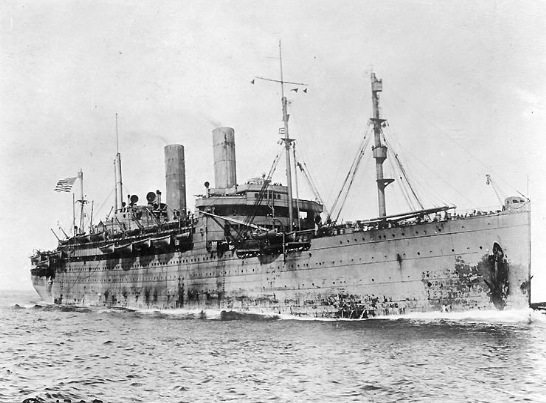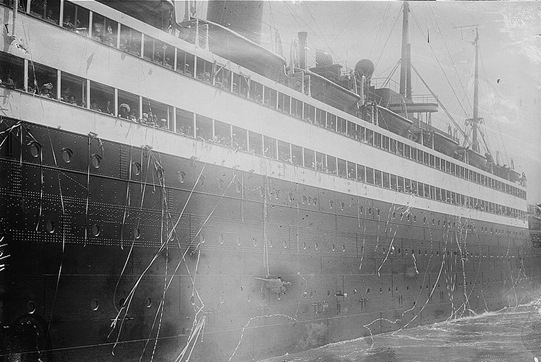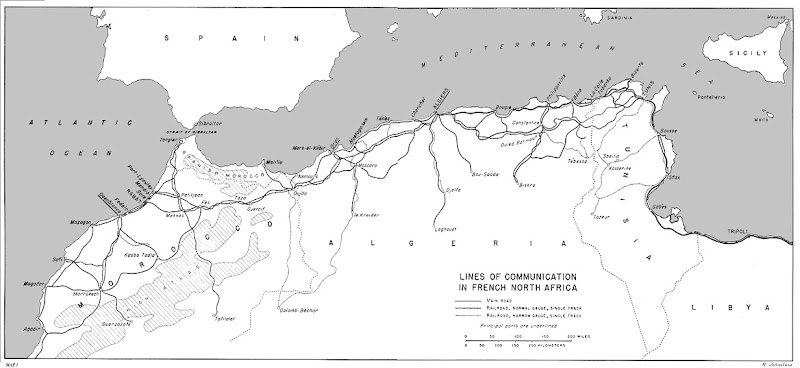Although much worse awaited him in North Africa, Bill’s trip there on the USS George Washington was miserable . He referred to it as “an old junker.” Built in 1908 it was originally fitted as an ocean liner. It had previously seen service in World War One when it was converted into a troop carrier by the US Navy. In April 1943 it was re-commissioned again as a troop carrier.
 USS George Washington as a troop carrier in World War One
USS George Washington as a troop carrier in World War One
Image Source: Wikipedia Commons
 USS George Washington in better days during a voyage between 1910 – 1915
USS George Washington in better days during a voyage between 1910 – 1915
Image Source: Wikipedia Commons
It was one ship among many travelling in a convoy carrying the entire 82nd Airborne Division. To safeguard the extremely valuable fighting force onboard they were accompanied by a naval escort including several destroyers. The Atlantic naval war was at it’s height at the time making the U-boat threat all too real. Bill said the convoy had to zigzag most of the way in an effort to minimize its vulnerability.
Ever since 1941 when Hitler declared war on the US, newsreels back home had given good coverage of Admiral Donitz’ “Wolf Packs” of U-boats sinking thousands of tons of shipping all over the Mediterranean and the Caribbean Seas and ominously closer to their present location the Atlantic. Bill said the George Washington broke down on the voyage taking an entire day to get underway and catch back up to the other ships. The time away from the convoy made the men anxious.
A veteran of Bill’s EGB unit recently told me a story about a U-boat encounter he witnessed while on the George Washington. He was on deck one night getting some fresh air when their destroyer escort suddenly picked up speed and began circling the ship. As it did, it dropped depth charges. They detonated fairly close to the ship sending up huge plumes of water. This went on for about half an hour as the destroyer chased the U-boat around. The cat and mouse pursuit eventually moved off into the distance and after a while the destroyer returned. The fate of the U-boat was never discovered.
The whole trip to Casablanca took a total of twelve days. It was a boring journey. To help, movies were shown in the afterdecks. Boxing and wrestling matches were held there too. A small library offered pocket books on various topics for loan.
The men were allowed on deck, but as you can see in the ship photographs above, that area was small and was usually crowded. When on deck the men watched the other ships and the destroyers in particular as they patrolled for U-Boats. False rumors quickly spread that each ship in the convoy had Nurses and other women service personnel from the WACs (Woman’s Army Corps) and Navy WAVES (Women Accepted for Volunteer Emergency Service). In truth there were no women on any of the ships.
Rumors abounded as to their destination. Some men thought England, others Ireland, or Malta. No one was particularly surprised when a couple of days into the trip they were informed it was in fact Casablanca, North Africa.
The dining facilities onboard were inconvenient, of inadequate capacity and of poor standard. There were too many men on board for the limited cooking facilities to keep up. This meant there were only two meals served a day per trooper even with the galley working around the clock.
The mess hall was a long narrow room with a long high bar like table where the men ate standing up. Each man took a tray and lined up in front of a counter while cooks served food onto mess kits. The food was piled up with bread on the bottom, vegetables and meat next, then ice-cream or other dessert on top. Some men refused to eat these unappetizing “meals”. Others couldn’t stomach them.
Except for a lucky few who volunteered to sleep on deck, most men slept in tiny cabins on hammocks hung four rows high, three across and two deep with orders to sleep for eight hours. There was no room in the cramped conditions to read, or write and it was difficult for many to even roll over.
On May 10, 1943 they anchored in the Port of Casablanca. Right from their point of disembarkation of the docks onwards the men were harassed by poor Arabs, who begged for anything, but notably mattress covers were the most sought after item. They were often the victims of thievery by these people who were so desperate they would literally steal anything not nailed down.
Bill and the rest of his unit of Easy Going Bastards marched five miles through the heat of the town in full gear to a field in the outskirts where they made a bivouac.
The wife of one veteran in Bill’s outfit told me of a story about her husband’s time in Casablanca. The trooper was invited by a relatively well off local man to a family dinner of roast chicken. The promise of a real home cooked meal was difficult to turn down so he readily accepted the kind offer. But the poor guy got a shock when dinner was served. To his disgust the local way to roast a chicken was with all the innards intact. When served the meal smelled awful and was understandably inedible. The trooper refused to each it and the local was greatly offended. The trooper gladly suffered the man’s scorn which was preferable to eating the meal. The trooper returned to camp hungry, but with his culinary ethics preserved.
A couple of days later on May 12th the 82nd Airborne boarded trains bound for Oujda, French Morocco (See map below). It was in Oujda where their base would be built in preparation for the invasion of Sicily code named Operation HUSKY.

North Africa Circa 1943
Source: United States Army in World War II Mediterranean Theater of Operations Northwest Africa: Seizing the Initiative In the West by George F. Howe, OFFICE OF THE CHIEF OF MILITARY HISTORY DEPARTMENT OF THE ARMYWASHINGTON, D.C., 1957 http://www.ibiblio.org/hyperwar/USA/USA-MTO-NWA/USA-MTO-NWA-2.html


